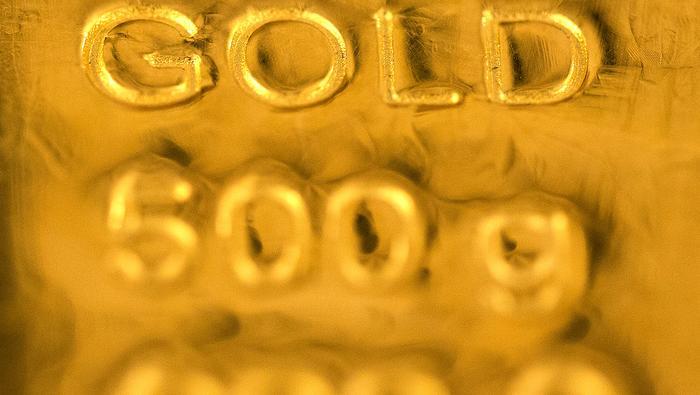2024-04-11 22:05
Most Read: British Pound Outlook & Sentiment Analysis - GBP/USD, GBP/JPY, EUR/GBP The euro weakened against the U.S. dollar and British pound on Thursday after the European Central Bank embraced a dovish posture during its April meeting. When it was all said and done, EUR/USD dropped by 0.2%, closing the session at 1.0725. EUR/GBP also retreated, falling 0.3% and breaching its 50-day simple moving average to settle at 0.8542. To provide some color, the ECB left its policy settings unchanged at the end of its last meeting, but unambiguously indicated that a shift to a looser stance is imminent amid increased confidence in the disinflation process. This guidance led traders to increase bets that the first rate cut of the central bank's easing cycle will come in June. The fact that the ECB is expected to ease before the Fed should be bearish EUR/USD in the near term. A few weeks ago, the Fed was also seen launching its easing cycle in June, but hotter-than-anticipated inflation readings, coupled with robust labor market data, have diminished the likelihood of this scenario, sparking a hawkish repricing of interest rate expectations that has been a tailwind for the greenback. The euro may also struggle against sterling on account of monetary policy divergence. Although the Bank of England is also on track to start lowering borrowing costs later this year, the institution led by Andrew Bailey is not likely to pull the trigger until August. Moreover, market pricing points to only 50 basis point easing from the BoE compared to the 75 basis points expected from the ECB. Want to know where the euro may be over the coming months? Explore all the insights available in our quarterly forecast. Request your complimentary guide today! EUR/USD FORECAST - TECHNICAL ANALYSIS After a steep sell-off on Wednesday, EUR/USD extended losses on Thursday, hitting its lowest mark in two months at one point during the trading session, before making a partial recovery. Should losses regain impetus in the coming days, support appears near February’s lows at 1.0695. Below this threshold, all eyes will be on 1.0640, followed by 1.0450. On the flip side, if selling pressure eases and sentiment towards the euro improves, we could potentially see a bullish reversal off current levels. In such a scenario, buyers could propel prices towards the 50-day and 200-day simple moving average located around 1.0825. On further strength, the focus will be on 1.0865, the 50% Fib retracement of the 2023 slump. EUR/USD PRICE ACTION CHART EUR/USD Chart Created Using TradingView Eager to discover how retail positioning can influence EUR/GBP’s short-term trajectory? Our sentiment guide has valuable insights about this topic. Grab a free copy now! EUR/GBP FORECAST - TECHNICAL ANALYSIS EUR/GBP rallied earlier in the month but began to retrace after facing rejection at trendline resistance at 0.8585, with losses accelerating and prices breaking below the 50-day simple moving average on Thursday. If weakness persists, support emerges at 0.8285. Bulls must resolutely defend this technical floor; a failure to do so might result in a descent towards the 2023 lows. Conversely, if EUR/GBP mounts a comeback, the first hurdle in its path to recovery will be the 50-day simple moving average, positioned near 0.8550. Beyond this resistance, attention will turn to a descending trendline spanning five months at 0.8575. Bulls may find it challenging to take out this barrier, but a breakout could trigger a move towards the 200-day simple moving, EUR/GBP PRICE ACTION CHART EUR/GBP Char Creating Using TradingView https://www.dailyfx.com/news/forex-euro-outlook-turns-bearish-after-ecb-decision-setups-on-eur-usd-eur-gbp-20240411.html

2024-04-11 14:30
Gold (XAU/USD), Silver (XAG/USD) Analysis Gold retreats after tagging a key Fibonacci extension XAU/USD bull run shows little sign of slowing down Silver hits a prior longer-term zone of resistance The analysis in this article makes use of chart patterns and key support and resistance levels. For more information visit our comprehensive education library Gold Retreats After Tagging 1.618 Fibonacci Extension The weekly gold chart showcases gold’s bullish continuation, taking out numerous all-time highs with ease. The prospect of fewer rate cuts from the Fed and a stronger US dollar have hardly affected the high-flying commodity which continues to thrive on solid central bank buying and a pickup in retail purchases from Chinese citizens. With gold breaking new ground, resistance targets are difficult to come by. Therefore, the 1.618% extension of the major 2020 to 2022 major decline helps project the next upside challenge at $2360. Price action does appear to have pulled away from the level but the move is minor at this juncture. Gold Weekly Chart Source: TradingView, prepared by Richard Snow Learn how to trade gold with our comprehensive Gold Trading Guide The daily chart portrays the extent to which this market is overheating, with the RSI continuing to trade in overbought territory. Prices trade well above both the 50 and 200-day simple moving averages, a bullish landscape for the metal. Today, gold appears to be stabilizing after yesterday’s hot CPI data which propelled yields and the dollar higher – effectively adding a premium to the price of gold for overseas buyers. The sheer pace of the advance suggests the invalidation levels for the bullish outlook appear at the prior all-time high of $2195. Even a move to the $2222 level wouldn’t necessarily rule out a further bullish move, but it may prompt a reassessment of the bullish bias. Gold Daily Chart Source: TradingView, prepared by Richard Snow Silver Hits a Prior, Longer-Term Zone of Resistance Silver, like gold, continues its bullish advance but has recently hit a zone of resistance that appeared in late 2020, and early 2021. The zone appears around $28.40 and capped silver prices around the Covid boom. The next target to the upside is $30.10 which represents a full retracement of the 2021 to 2022 decline. Should the level propel bulls from here, the 78.6% retracement comes into play at $27.41, followed by $26.10. Silver Weekly Chart Source: TradingView, prepared by Richard Snow The daily chart hones in on recent price action which appears to stabilise beneath the zone of resistance. Notably, the RSI flashes red as silver continues to trade in overbought territory, suggesting bulls may need to catch their breath. Silver Daily Chart Source: TradingView, prepared by Richard Snow https://www.dailyfx.com/news/gold-silver-technical-forecast-price-action-setups-analysed-20240411.html

2024-04-11 13:02
EUR/USD Prices, Charts and Analysis ECB edges further towards a June rate cut. Will President Lagarde begin signaling further rate cuts? The ECB left all policy levers untouched as expected, but mentioned in the press statement that, ‘If the Governing Council’s updated assessment of the inflation outlook, the dynamics of underlying inflation and the strength of monetary policy transmission were to further increase its confidence that inflation is converging to the target in a sustained manner, it would be appropriate to reduce the current level of monetary policy restriction.’ Last meeting the ECB mentioned June as a potential meeting for a policy decision, and today’s meeting adds to the view that the ECB will cut on June 6th. Financial markets continue to price in a 25 basis point at the June meeting and have recently increased the probability of an additional cut at the July 18th meeting. It may well be that the ECB cuts twice before the Fed makes its first move. EUR/USD fell sharply yesterday, due to post-CPI US dollar strength, leaving the Euro as the next driver of any move. Initial support is seen around 1.0698, a double-low made in early February, before the 1.0635 – May 31st swing-low – and 1.0610 – Fibonacci retracement – come into play. EUR/USD Daily Price Chart Charts using TradingView Retail trader data shows 68.14% of traders are net-long with the ratio of traders long to short at 2.14 to 1.The number of traders net-long is 51.05% higher than yesterday and 56.59% higher than last week, while the number of traders net-short is 42.48% lower than yesterday and 43.78% lower than last week. We typically take a contrarian view to crowd sentiment, and the fact traders are net-long suggests EUR/USD prices may continue to fall. What is your view on the EURO – bullish or bearish?? You can let us know via the form at the end of this piece or you can contact the author via Twitter @nickcawley1. https://www.dailyfx.com/news/ecb-leaves-rates-unchanged-rate-cut-looms-eur-usd-steady-ahead-of-press-conference-20240411.html

2024-04-11 08:06
Japanese Yen (USD/JPY) Analysis Dollar response to hot CPI data sends USD/JPY higher USD/JPY enters a danger zone as the FX intervention threat looms Dollar yen breaks 152.00 and enters overbought territory Elevate your trading skills and gain a competitive edge. Get your hands on the Japanese Yen Q2 outlook today for exclusive insights into key market catalysts that should be on every trader's radar: Dollar Response to Hot CPI Data Sends USD/JPY Higher The disconnect between the dollar and US yields in recent trading sessions presented an opportunity for USD bulls to bridge the gap if inflationary pressures showed up in the March CPI report. Indeed, US CPI beat consensus estimates across the board with headline and core inflation surpassing expectations on both the year-on-year as well as month-on-month readings. In the buildup to the data, US 10 and 2-year treasury yields had been rising steadily while the US dollar – via the US dollar basket (DXY) – was experiencing a decline. In response to the inflation data, US yields shot up even more, compelling the dollar to follow suit, resulting in a higher USD/JPY price. The chart below highlights the move in USD/JPY and the increasing yield differential between the US and Japan which is helping to drive the carry trade. USD/JPY Daily Chart with the US/Japan 10-year yield differential Source: TradingView, prepared by Richard Snow USD/JPY Enters a Danger Zone as the FX Intervention Threat Looms With USD/JPY around 153.00, both the finance minister and deputy finance minister issued their displeasure at the unfavourable volatility associated with the yen’s recent decline. The messages echoed what we have heard before however, the finance minister Mr Suzuki addressed the levels of 152.00 and 153.00 when explaining it is not the level of dollar yen that is in focus, rather the background that has led to the weakness. Nevertheless, USDJPY trades above the prior intervention level (152.00) and appears to hold comfortably around 153.00. The chart below provides context for the pair, charting a new path at such elevated levels. The blue and red rectangles have been used as guides based on the average price move exhibited over the last two quarters. The potential upside target appears unrealistic as the finance ministry and BoJ are likely to intervene well before prices get that high, while the downside level may come into play should FX intervention be deployed to strengthen the yen amid the prospect of another rate cut from the BoJ later this year. One thing that continues to work against the yen is the fact that the carry trade is still very appealing, borrowing yen at low interest rates to invest in the higher-yielding USD. Additionally, given strong economic, jobs and inflation data, the Fed is likely to consider fewer rate cuts this year and potentially deciding to hold rates at current levels. USD/JPY Weekly Chart Source: TradingView, prepared by Richard Snow The dollar yen pair is one of the most liquid, most highly trades pairs in the word. It has strong links to international trade and is well known for facilitating the 'carry trade' . Find out more by reading the DailyFX guide below: USD/JPY Breaks 152.00 and Enters Overbought Territory USD/JPY held the overnight level, around 153.00 as the pair enters overbought territory. Before the bullish catalyst, the pair had traded within a narrow range beneath the 152.00 marker. The risk-to-reward ratio of a bullish continuation appears highly unfavourable at such elevated levels. Keep an eye out for communication suggesting the BoJ/finance ministry has contacted banks looking for FX quotes – if the prior intervention playbook can be used. USD/JPY Daily Chart Source: TradingView, prepared by Richard Snow https://www.dailyfx.com/news/usd-jpy-outlook-hot-us-inflation-propels-usd-jpy-to-worrying-levels-20240411.html

2024-04-10 20:30
Most Read: US Inflation Jumps, Rate Cut Expectations Pared Back Sharply, Gold Slides The U.S. dollar rallied vigorously on Wednesday, fueled by hotter-than-expected U.S. inflation numbers. This upswing propelled USD/JPY to fresh 2024 highs and to its strongest level since 1990. For context, the March Consumer Price Index report revealed a persistent inflationary environment in the North American economy, diminishing hopes for a June FOMC rate cut. Focusing on today's data, headline CPI climbed 3.5% year-over-year, exceeding forecasts and accelerating from February's 3.2% reading. The core gauge, which strips out volatile energy and food costs, also surprised on the upside, clocking in at 3.8% versus the expected 3.7% - a sign that price pressures may be regaining momentum. Wall Street reacted swiftly, pushing U.S. Treasury yields upwards across the board on bets that the Federal Reserve may be compelled to maintain a restrictive position for an extended period. Against this backdrop, the U.S. 2-year yield jumped more than 20 basis points, coming within striking distance from recapturing the 5.0% psychological mark. Want to know where the U.S. dollar may be headed over the coming months? Explore key insights in our second-quarter forecast. Request your free trading guide now! Source: TradingView Traders also adjusted their view on the FOMC’s trajectory, pushing back on the timing and magnitude of future reductions in borrowing costs. That said, futures contracts now price in less than 40 basis points of easing for the year, with the first potential cut likely occurring in September. The table below shows current meeting probabilities. Source: CME Group Earlier this month, Fed Chair Powell downplayed concerns about inflation during a speech at the Stanford Business, Government, and Society Forum. However, three consecutive months of hotter-than-expected CPI figures may prompt a reassessment of the policy outlook. This could potentially lead to more hawkish rhetoric in the upcoming days and weeks – a bullish outcome for the U.S. dollar. While the greenback may consolidate to the upside in the near term, it is uncertain whether it can continue to appreciate relentlessly against the yen, as Japanese authorities may soon step in to support the domestic currency, with USD/JPY trading at levels not seen in nearly 34 years. Delve into how crowd psychology may influence FX market dynamics. Request our sentiment analysis guide to grasp the role of retail positioning in predicting USD/JPY’s near-term direction. USD/JPY TECHNICAL ANALYSIS USD/JPY blasted past resistance at 152.00 on Wednesday, hitting its strongest mark since June 1990. If Tokyo doesn't ramp up verbal intervention or move in quickly to contain the yen's decline, speculators may feel emboldened to initiate an attack on the upper boundary of a medium-term ascending channel located near 155.70. On the flip side, if prices turn lower and head back below 152.00, a possible support area emerges at 150.90. Bulls are likely to vigorously defend this area; failure to do so could spark a retracement towards the 50-day simple moving average at 150.00. Below this threshold, all eyes will be on channel support near 149.25. USD/JPY PRICE ACTION CHART USD/JPY Chart Created Using TradingView https://www.dailyfx.com/news/forex-us-dollar-soars-after-us-cpi-data-usd-jpy-stages-bullish-breakout-what-now-20240410.html

2024-04-10 19:00
In the dynamic realm of forex trading, emerging market currency pairs have garnered significant attention from traders worldwide in recent years. These pairs, which involve currencies from developing economies, offer a unique blend of volatility and potential returns. Among the diverse array of options available, several emerging market forex pairs stand out for their popularity and trading opportunities against the US dollar. Let's delve into strategies tailored for each of these prominent pairs. Want to know where the U.S. dollar may be headed over the coming months? Explore all the insights available in our quarterly forecast. Request your complimentary guide today! Mexican Peso (USD/MXN): USD/MXN, featuring the US dollar against the Mexican peso, is a cornerstone of emerging market forex trading. Mexico's close economic ties with the United States and its status as a major exporter contribute to the pair's volatility. When trading USD/MXN, it's crucial to monitor US economic indicators, particularly those related to trade, as they often influence the peso's performance. Traders keen on USD/MXN often leverage technical analysis tools to identify key support and resistance levels. Additionally, staying informed about geopolitical developments in North America and Mexico can provide valuable insights into potential market movements. Given the pair's volatility, implementing risk management strategies such as setting stop-loss orders and diversifying positions is essential to manage exposure effectively. Brazilian Real (USD/BRL): USD/BRL, featuring the US dollar against the Brazilian real, offers traders exposure to Brazil's vibrant economy and its role as a major commodity exporter. Brazil's economic policies, along with global trends in commodity markets, significantly influence the pair's movements. When trading USD/BRL, it's essential to monitor developments in Brazil's agricultural and industrial sectors, as well as any regulatory changes impacting the economy. Traders often employ a combination of technical and fundamental analysis to navigate the USD/BRL pair's volatility. Trend-following strategies, such as moving average crossovers, can help identify potential entry and exit points. Moreover, keeping abreast of Brazil's monetary policy decisions and political developments can provide valuable insights for trading. Robust risk management practices, including position sizing and using trailing stops, are imperative when trading USD/BRL. South African Rand (USD/ZAR): USD/ZAR, featuring the US dollar against the South African rand, attracts traders with its volatility and exposure to South Africa's commodity-driven economy. Factors such as commodity prices, South Africa's fiscal policies, and geopolitical developments influence the pair's movements. When trading USD/ZAR, it's essential to monitor global trends in commodity markets, as well as South Africa's economic indicators and political landscape. Traders often utilize a combination of technical analysis indicators, such as RSI and MACD, to identify potential trading opportunities in USD/ZAR. Additionally, staying informed about South Africa's economic reforms and any shifts in investor sentiment towards emerging markets can help guide trading decisions. Implementing risk management strategies, such as setting stop-loss orders based on volatility levels, is crucial given the pair's propensity for sharp price movements. Indian Rupee (USD/INR): USD/INR, featuring the US dollar against the Indian rupee, offers traders exposure to India's rapidly growing economy and its role as a major player in the global market. India's fiscal and monetary policies, along with geopolitical developments, influence the pair's movements. When trading USD/INR, it's essential to monitor India's economic indicators, such as GDP growth and inflation rates, as well as global factors impacting investor sentiment towards emerging markets. Traders often employ a range of technical analysis tools, such as Fibonacci retracements and pivot points, to identify potential entry and exit points USD/INR. Moreover, staying informed about India's structural reforms and any shifts in its trade policies can provide valuable insights for trading. Given the pair's volatility, implementing risk management strategies, such as using trailing stops and diversifying positions across multiple currency pairs, is essential for prudent trading. Chinese Yuan (USD/CNH): USD/CNH, featuring the US dollar against the offshore Chinese yuan, offers traders exposure to China's rapidly evolving economy and its role as a global economic powerhouse. China's monetary policies, trade relations, and geopolitical developments influence the pair's movements. When trading USD/CNH, it's essential to monitor China's economic indicators, such as GDP growth and industrial production, as well as any regulatory changes impacting the offshore yuan market. Traders often leverage technical analysis techniques, such as trendlines and chart patterns, to identify potential trading opportunities in USD/CNH. Additionally, staying informed about developments in US-China trade relations and any shifts in market sentiment towards the Chinese yuan can provide valuable insights for trading. Implementing risk management strategies, such as setting stop-loss orders based on volatility levels and closely monitoring position sizes, is crucial given the pair's sensitivity to external factors. In conclusion, trading popular emerging market forex pairs against the US dollar offers traders ample opportunities for attractive setups albeit with inherent volatility and risks. By staying informed about economic indicators, and geopolitical developments, and employing a combination of technical and fundamental analysis, traders can navigate these pairs with confidence and consistency. Implementing robust risk management strategies is imperative to safeguard against unexpected market movements and ensure sustainable trading success. https://www.dailyfx.com/news/trading-emerging-market-forex-pairs-usd-mxn-usd-brl-usd-zar-usd-inr-usd-cnh-20240410.html
